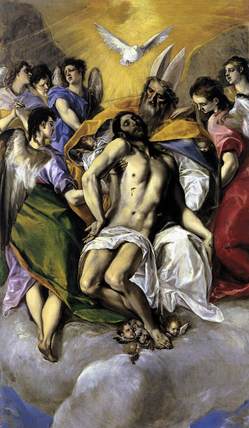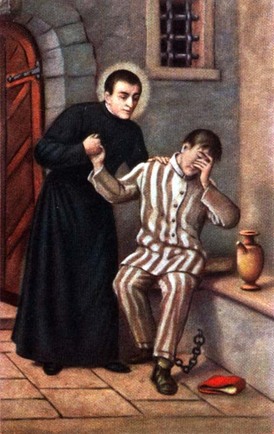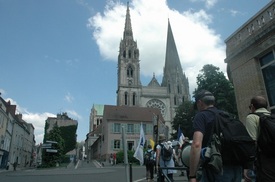 ENDOW (Educating on the Nature & Dignity of Women) is a Catholic educational program bringing women together to discover what it means to be a woman, made in God’s image and likeness holding a God-given dignity known in being a person. ENDOW is a new feminism promoting the beauty of being a woman.
ENDOW (Educating on the Nature & Dignity of Women) is a Catholic educational program bringing women together to discover what it means to be a woman, made in God’s image and likeness holding a God-given dignity known in being a person. ENDOW is a new feminism promoting the beauty of being a woman.
Category: Spiritual Life
Is our love enlarged enough to trust the other?
The work of holiness is supposedly on our lists of things “to do.” Yet, we bounce from thing to thing, place to place, guru to guru without considering the true source of holiness and how holiness develops. Yes, it is a work but it is not something imposed on us by an external force. As St Gregory of Nyssa once said, “For the quality of holiness is shown not by what we say but by what we do in life.” No gift can be imposed on someone, neither from God nor from another. We can never take a gift but only be open to receiving a gift. This is particularly true in meeting God and a friend.
us is so low, why our attachments are so poor, our view of life so dim, our
belief so unreal, our general notions so artificial and external is this, that
we dare not trust each other with the secret of our hearts. We have each the
same secret, and we keep it to ourselves, and we fear that, as a cause of
estrangement, which really would be a bond of union. We do not probe the wounds
of our nature thoroughly: we do not lay the foundation of our religious
profession in the ground of our inner man: we make clean the outside of things:
we are amiable and friendly to each other in words and deeds, but our love is
not enlarged, our bowels of affection are straightened, and we fear to let
intercourse begin at the root: and in consequence, our religion viewed as a
social system is hollow, the presence of Christ is not in it. (Plain and
Parochial Sermons, V, pp. 126-7).
Thomas à Kempis
Holy Father, you have nourished and strengthened your Church by the inspired writings of your servant Thomas a Kempis: Grant that we may learn from him to know what is necessary to be known, to love what is to be loved, to praise what highly pleases you, and always to seek to know and follow your will;
through Jesus Christ our Lord, who lives and reigns with you and the Holy Spirit, one God, for ever and ever.
Looking toward a time of peace, reconciliation and social justice
I’ve had some spare time to read and so this morning I pondered the address given by Archbishop Agostino Marchetto, Secretary of the Pontifical Council for the Pastoral Care of Migrants and Itinerant People at the 2010 Conference of European University Chaplaincies, 14-18 June 2010. The title of the address is “Young hearts and minds toward ‘Peace, Reconciliation, and Social Justice.”
A few paragraphs that I thought would be germane for reflection and deeper prayer.
Pope John Paul II … wrote that “forgiveness is above all a personal choice, a decision of the heart to against the natural instinct to pay back evil with evil. The measure of such a decision is the love of God who draws us to himself in spite of our sin. Forgiveness therefore has a divine source and criterion. Forgiveness, as a fully human act, is above all a personal initiative (World Day of Peace message 2002). The ability to forgive lies at the very basis of the idea of a future society marked by justice and solidarity. Peace is essential for development, but true peace is made possible only through forgiveness and reconciliation” (ibid).
Pope Benedict XVI, in his Message to the youth in 2007, invited them to “dare to love” and not to desire anything less for their life than a love that is strong and beautiful: love that is capable of making the whole of their existence a joyful undertaking of giving themselves as a gift to God and their brothers and sisters, in imitation of the One who vanquished hatred and death forever through love (cf. Rev 5:13). Love is the only force capable of changing the heart of the human person and of all humanity, by making fruitful the relations between men and women, between rich and poor, between cultures and civilizations.
Pope John Paul II in fact was convinced that the future far lies in the hands of the youth. The future of peace lies in their hearts. To construct history, as they can and must, they to free history from the false paths it is pursuing. To do this, the youth must have a deep trust in the grandeur of the human vocation -a vocation to be pursued with respect for truth for the dignity and inviolable rights of the human person. Pope Wojtyla felt the feeling of the modern youth indeed. He said that he saw them being touched by the hunger for peace; that they are troubled by so much injustice around them and sense overwhelming danger in the gigantic stockpiles of arms and in the threats of nuclear war; that they suffer when they see widespread hunger and malnutrition and are concerned about the environment today and for the coming generations; that they are threatened by unemployment and many already without work and without the prospect of meaningful employment and are upset by the large number of people who are oppressed politically and spiritually and who cannot enjoy the exercise of their basic human rights as individuals or as a community. All this can give rise to a feeling that life has little meaning. In this situation, some may be tempted to take flight from responsibility: in the fantasy worlds of alcohol and drugs, in short-lived sexual relationships without commitment to marriage and family, in indifference, in cynicism and even in violence. Pope John Paul II invited them therefore to be themselves on guard against the fraud of a world that wants to exploit or misdirect their energetic and powerful search for happiness and meaning. He invited them not to avoid the search for the true answers to the questions that confront them (World Day of Peace 1985).
L’Osservatore Romano
June 23, 2010
Facing our reality, a monk tells
Facing our own reality, as it is present to us right now, can be an extraordinarily painful experience. Living in either the past or the future is not of the Holy Spirit. But we sometimes find ourselves nursing old wounds, angers, being scared by weaknesses. However, experience tells us if we look carefully, that living reality is superbly beautiful and freeing and loving, too. Fr Giussani points us to keep life real, to be faithful to life and to accept the grace of recognizing that Christ is in the center of life. Easier said than done most days. One’s sin can be overwhelming and it has the ability to define our being if we are not careful. I found the following paragraph of Abbot Alban’s to be helpful and real; he names the virtues we need to live as God wants us to live. Perhaps you’ll take some solace from Abbot Alban’s brief note, too,
Time and again, during our life, we shall meet with
hardships which are the inevitable accompaniment of any attempt to lead a
supernatural life on this earth. These will arise not only from the temptations
which … are the consequence of our own weakness and fault but also from all
those trials and problems that arise from circumstances and people beyond our
own control, things which will demand from us much humility, fortitude,
generosity, forgiveness, patience with the “personality problems” [of others],
patience with ourselves…. Only the spirit of compunction of heart will enable
us to accept them … [and] to transform them from bitter frustrations into a
patient and even joyful sharing of the sufferings of Christ.
Alban Boultwood,
Alive to God: Meditations for Everyone (Baltimore: Helicon, 1964), 64.
Invitation to send intentions to the Apostleship of Prayer
Father James
Kubicki, director of the Apostleship of Prayer, posted
a note on his website inviting pray-ers/readers to send him possible prayer
intentions.
As he said, “People often ask us where the Pope’s prayer intentions
come from. That’s a great question with a great answer: they come
from the Pope. And they can even come from you. If you have a prayer
intention and would like more than 50 million people to pray for it, I invite
you to send it to us, keeping in mind that it should be something that concerns
the needs of the Church and the world. We forward intentions to our
international office in Rome, where a number of them are selected to present to
the Holy Father.”
This is important to do. As you know, on the first day of each month I post for our prayer the intentions given by Pope Benedict to this Apostleship of Prayer. Well, they come from somewhere, written and proposed by someone, coming from real experience and real need that are placed before God.
You may send Father Kubicki your proposed prayer intention by
reply e-mail or mail:
Apostleship of Prayer
3211 South Lake
Drive, Suite 216
Milwaukee, WI
53235-3717
(414) 486-1152
info@apostleshipofprayer.org
PS: Don’t forget to make your daily morning offering, today!
Saint Joseph Cafasso: patron for prisoners and spiritual directors
The Pope’s weekly general audience address today was
dedicated to Saint Joseph Cafasso (1811-1860), a member of the “St Francis of
Assisi Institute,” a priest (ordained in 1833) who died 150 years ago. He is
most known as Saint John Bosco’s spiritual father (director) from 1835 to 1860.
Cafasso died in 1860; Pius XII canonized in him 1947. In 1948, Pope Pius XII named him the patron of Italian
prisons and, in 1950, proposed him “as a model for priests involved in
Confession and spiritual direction.” His uncle is Blessed Joseph Allamano. Saint Joseph Cafasso’s feast day is June 23.
I never heard of Saint Joseph Cafasso
until today, partly because I am not well attuned to the life of Saint John
Bosco of which he seems to be most connected. According to the Benedict, Joseph
Cafasso’s ministry helped to form “the true pastor with a rich interior life
and a profound zeal for pastoral care: faithful in prayer, committed to
preaching and catechesis, dedicated to the Sacraments of the Eucharist and
Confession, in keeping with the model incarnated by St. Charles Borromeo and
St. Francis of Sales, and promoted by the Council of Trent. St. Joseph Cafasso
sought to establish this model in the formation of young priests so that, in
their turn, they too could become formators to other priests, religious and lay
people, thus creating a unique and effective chain.” AND how could anyone NOT take Saint Joseph Cafasso as a paradigm for Christian life?
A theme that I am picking
up these days from some of the Pope’s addresses is the constant need to stay in
the “state of grace.” You might say, “no Kidding, Paul! Really?” Mock if you want, but there is an increasing distancing from God, especially staying close to God by means of staying in
a state of grace through the sacrament of confession. We know that the pure of heart are the ones who inherit the kingdom of God. One of the things we know
of Saint John Vianney is that he devoted himself to confessional. Cafasso, the
Pope said, “loved the Lord totally, he was animated by a well-rooted faith and
supported by profound and prolonged prayer, he showed sincere charity to
everyone. He knew moral theology but was equally well aware of the condition of
people’s hearts for which, like the good shepherd, he took responsibility.”
Benedict
XVI explained that that Saint John Bosco never copied his master. Not an
insignificant point: we need to take under consideration those who guide us but
we also need to assert our independence from a “master teacher” in order for
grace to flourish. Otherwise we
merely parrot the other in an unthinking manner. The Pope said, “He
imitated him in the human and priestly virtues – defining him as a ‘model of
priestly life’ – but maintained his own attitudes and his own specific
vocation. … This is a precious lesson for those involved in the formation and
education of the young generations.”
What may be interesting for us to
know is that Saint Joseph Cafasso was renown for his “concern for the lowest, especially for prisoners
… who lived in inhuman and dehumanizing conditions.” Characteristic of Cafasso’s
work with prisoners is remembered today as he “often delivered great sermons
that came to involve almost the entire prison population, with the passage of
time he came to favor individual catechesis, made up of conversations and
personal meetings. While respecting the individual situation of each
individual, he tackled the great themes of Christian life, speaking of trust in
God, adherence to His will, the utility of prayer and the Sacraments, the
culmination of which is Confession, the meeting with God Who, for us, becomes
infinite mercy.”
Novena in Honor of Blessed Pier Giorgio Frassati begins today
 Today begins nine days of prayer in honor of Blessed Pier Giorgio Frassati, “the man of the 8 Beatitudes.”
Today begins nine days of prayer in honor of Blessed Pier Giorgio Frassati, “the man of the 8 Beatitudes.”
Pilgrimage to Chartres
 Going from point A to point B whether it is a physical move or a spiritual one is a pilgrimage. Something happens to the person making the move between points. Traditionally speaking a pilgrimage is not a tourist event nor is a undertaken for frivolous reasons. Tourism is fine and necessary but I want to think about a different type physical and spiritual journey not often talked about in Catholic circles today. It is a journey; it’s a path walked; it is a time to review your life. A pilgrimage is time spent either alone or with others on a path to a change of heart, a conversion. Often we take on the burdens and the delights of a pilgrimage to gain a deeper insight into our lives as Christians asking questions about how the experience of Christ has changed me, or where I need to change based on what I discern the Lord to be asking.
Going from point A to point B whether it is a physical move or a spiritual one is a pilgrimage. Something happens to the person making the move between points. Traditionally speaking a pilgrimage is not a tourist event nor is a undertaken for frivolous reasons. Tourism is fine and necessary but I want to think about a different type physical and spiritual journey not often talked about in Catholic circles today. It is a journey; it’s a path walked; it is a time to review your life. A pilgrimage is time spent either alone or with others on a path to a change of heart, a conversion. Often we take on the burdens and the delights of a pilgrimage to gain a deeper insight into our lives as Christians asking questions about how the experience of Christ has changed me, or where I need to change based on what I discern the Lord to be asking.
Prayer to the Trinity by Blessed Elizabeth of the Trinity
 O my God, Trinity whom I adore; help me to forget myself entirely that I may be established in You as still and as peaceful as if my soul were already in eternity. May nothing trouble my peace or make me leave You, O my Unchanging One, but may each minute carry me further into the depths of Your mystery. Give peace to my soul; make it Your heaven, Your beloved dwelling and Your resting place. May I never leave You there alone but be wholly present, my faith wholly vigilant, wholly adoring, and wholly surrendered to Your creative Action.
O my God, Trinity whom I adore; help me to forget myself entirely that I may be established in You as still and as peaceful as if my soul were already in eternity. May nothing trouble my peace or make me leave You, O my Unchanging One, but may each minute carry me further into the depths of Your mystery. Give peace to my soul; make it Your heaven, Your beloved dwelling and Your resting place. May I never leave You there alone but be wholly present, my faith wholly vigilant, wholly adoring, and wholly surrendered to Your creative Action.
O my beloved Christ, crucified by love, I wish to be a bride for Your Heart; I wish to cover You with glory; I wish to love You…even unto death! But I feel my weakness, and I ask You to “clothe me with Yourself,” to identify my soul with all the movements of Your Soul, to overwhelm me, to possess me, to substitute yourself for me that my life may be but a radiance of Your Life. Come into me as Adorer, as Restorer, as Savior.
O Eternal Word, Word of my God, I want to spend my life in listening to You, to become wholly teachable that I may learn all from You. Then, through all nights, all voids, all helplessness, I want to gaze on You always and remain in Your great light. O my beloved Star, so fascinate me that I may not withdraw from Your radiance.
O consuming Fire, Spirit of Love, “come upon me,” and create in my soul a kind of incarnation of the Word: that I may be another humanity for Him in which He can renew His whole Mystery. And You, O Father, bend lovingly over Your poor little crature; “cover her with Your shadow,” seeing in her only the “Beloved in whom You are well pleased.”
O my Three, my All, my Beatitude, infinite Solitude, Immensity in which I lose myself, I surrender myself to You as Your prey. Bury Yourself in me that I may bury myself in You until I depart to contemplate in Your light the abyss of Your greatness.
(Blessed Elizabeth of the Trinity, 21 November 1904)


